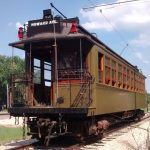Rapid Transit Cars

Northwestern Elevated 24
| Description: | Railroad-roof wood gate car |
Equipment Information
Northwestern Elevated Railroad 24 is the oldest operating Chicago ‘L’ car and the oldest preserved ‘L’ car at IRM. Car 24 is a “gate car,” built with open platforms with gates rather than enclosed ends with doors. It also has longitudinal seating, known as a “bowling alley” arrangement. It was one of the original cars built for the NWERR when that company, a predecessor of Chicago Rapid Transit, first constructed the North Side Main Line elevated (now the north end of the Red Line).
Northwestern Elevated Railroad 24 Details
Builder: Pullman
Year Built: 1898
Seats: 42
Length: 46ft 1in
Width: 8ft 8in
Height: 12ft 7in
Weight: 65000 lbs
Brakes: AMR
Motors: 2 GE 55
Control: M-C36
Compressor: D3-EG
Trucks: McGuire / Hedley
Description: Double End / Double Truck / Railroad Roof / Wood / ex-Chicago Rapid Transit 1024
Arrived: 1958
Condition: Complete / restored / operational
Northwestern Elevated Railroad 24 Ownership History
1898-1913 – Northwestern Elevated Railroad #24
1913-1924 – Chicago Elevated Railway #1024
1924-1947 – Chicago Rapid Transit #1024
1947-1954 – Chicago Transit Authority #1024
1954-1958 – Chicago Transit Authority #S111
1958-present – Illinois Railway Museum, Union, IL
Elevated Railways
Among the most iconic features of Chicago is its elevated system, known simply as the ‘L.’ Chicago was a pioneer in elevated railways and boasted the nation’s first electrified elevated line as well as the first use of multiple-unit equipment.
The first ‘L’ in Chicago was actually the Intramural Railway, an electrically-powered line that was built on the grounds of the 1893 Columbian Exposition for the purpose of transporting visitors around Jackson Park. Quick to follow was the South Side Rapid Transit, built from the Loop to the south side of the city. The elevated construction allowed for faster transit times than previously possible by avoiding entirely the street traffic below.
The South Side elevated line started out using small steam engines pulling trains of wooden coaches, but by the end of the 19th century the elevated lines in Chicago had become the first in the country to convert to electric operation. The early electric ‘L’ cars, like car 24, were utilitarian for their day. Seating was on wicker benches along the sides of the car, and entry was via an open platform enclosed by metal gates. It was this latter feature that gave these cars their nickname: “gate cars.” They used an early form of multiple-unit control, designed by General Electric, that enabled trains of self-propelled coaches to operate together.
What started out as a single line from downtown to the south side, operated with trains of austere wooden “gate cars,” eventually blossomed into the current CTA ‘L’ system of more than 200 miles. Yet even today’s computerized CTA cars trace their lineage directly to the 19th century “gate cars.” Chicago’s newest ‘L’ cars are also the same length and width as car 24, use the same 600-volt direct current electric power source, and use the same seating arrangement. The line from the CTA’s 19th century origins to the present day is a short one indeed.
Click to return to Rapid Transit Car roster
Click to return to main roster page
